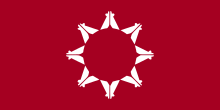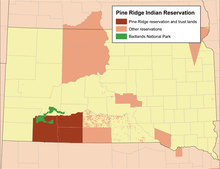Pine Ridge Reservation

The Pine Ridge Reservation ( Lakota language Oglala Oyanke ) is an Indian reservation in the southwest of the US state South Dakota on the border with Nebraska . The reserve extends over an area of approximately 11,000 km². Most of the Oglala - Lakota inhabited reservation is in Oglala Lakota County and Jackson County . The main town is Pine Ridge .
The reservation's unemployment rate is 85%, and in 2002 more than 40% of families on the US reservations lived below the poverty line . The suicide rate is around four times the national average. Many families have neither electricity nor a telephone. With a life expectancy of 47 years for men and just over 50 years for women, the life expectancy of the residents of the reserve is one of the shortest of any group in the western hemisphere .
About 75 percent of the households on Pine-Ridge secure their livelihood through various traditional forms of subsistence farming such as hunting small game, collecting wild fruits, roots and seeds or (less often) some horticulture. In addition to self-sufficiency , these products are also sold to other Lakota families or in the towns around the reserve.
history
The Pine Ridge Reservation was originally part of the Great Sioux Reservation , which was established by the Treaty of Fort Laramie in 1868 and originally comprised 240,000 km² in South Dakota, Nebraska and Wyoming. In 1876 the US government violated the Treaty of 1868 and opened 31,000 km² of the area of the reserve in the Black Hills for private interests. In 1889, the remaining area of the Sioux reservation was divided into seven separate reservations: Cheyenne River Reservation , Crow Creek Indian Reservation , Lower Brule Reservation , Rosebud Reservation , Sisseton Reservation , Yankton Reservation, and Pine Ridge Reservation.
In 1911, the Pine Ridge Reservation was further reduced: Bennett County was removed from the reservation as a result of the Allotment Act , but this is still not recognized by the Oglala. Oglala today are over half of Bennett County's population, but only own about a third of the country.
In 1942, the American federal government confiscated 1,383 km² of the reservation area (privately owned at that time) to establish a bomb test site for the United States Army Air Forces , called the "Badlands Bombing Range". 125 families had to leave the area as it was massively bombed. After the war, parts of the area were used as artillery training grounds by the South Dakota National Guard, called the "Badlands gunnery range". The Act Public Law 90 to 468 1968 202 357 were Acres returned (818.91 square kilometers) on the reserve. The area was currently contaminated by duds . In 2008 the US Air Force decided to invest 1.6 million dollars in cleanup work. On October 3, 2011, the last four known duds were detonated in a controlled manner. However, the owners of the land never received adequate compensation.
The Pine Ridge Reservation is one of the poorest areas in the United States. In the 1970s there was a civil war there. From 1972 to 1976 Dick Wilson was the tribal chief of the Oglala Lakota on the reservation. During Wilson's tenure, there were a number of violent and civil war-like clashes with the newly formed American Indian Movement (AIM), whose activists mostly did not come from the reservations, as well as police forces and the FBI. Several attempts to depose Wilson failed.
The occupation of the village of Wounded Knee on the reservation on February 27, 1973 by AIM activists became known immediately after a failed impeachment proceedings against Wilson.
In 1975 there was a shooting at the Jumping Bull Ranch on the reservation, in which two FBI agents, Ronald A. Williams and Jack R. Coler, and an AIM activist were shot. Of the four AIM members arrested for the shooting, two were acquitted, one was dismissed and the fourth, Leonard Peltier , was sentenced to life imprisonment in a separate and controversial trial. The proceedings received worldwide attention and the incidents were filmed several times.
The film Smoke Signals was shot in the reserve . The plot of the feature film Halbblut (original title Thunderheart ) was inspired, among other things, by the so-called Pine Ridge shootout from 1973 described above , and director Michael Apted shot the documentary incident in Oglala (OT: Incident at Oglala ), which deals with the events of 1973. In 2008 the Swiss documentary No More Smoke Signals , which focuses on the KILI radio station , also dealt with the situation in the reserve.
Jobs in the reserve are now being created by their own companies that market Indian products. Tanka Bar , a traditional food made from buffalo meat and cranberries , is now available in 3,000 stores in 49 US states. This is done through the Native American Natural Foods company founded by Karlene Hunter and Mark Tilsen . Another company producing on the reservation is Lakota Solar Enterprises , which makes solar modules for heating and cooking technology. It was founded by a descendant of the Lakota chief Red Cloud , by Henry Red Cloud.
In August 2013, the residents of the reservation decided in a referendum to lift the alcohol ban that had been in effect since it was founded. This is intended to recognize the real alcohol dependency of a large number of residents, at the same time to deprive the border towns outside of the reservation of the basis of their business and to reduce the high number of car accidents of drunken reservation residents on return. To date, the result of the referendum has not been implemented. The sale and consumption of alcohol is still officially prohibited. See also Whiteclay Nebraska.
See also
Web links
- Official site of the Oglala Sioux Indians (English)
- "Friends of the Pine Ridge Reservation" (English)
- KILI RADIO 90.1 FM The Voice Of the Lakota Nation (English)
Individual evidence
- ↑ Pine Ridge Reservation ( English ) In: Geographic Names Information System . United States Geological Survey . Retrieved January 30, 2011.
- ^ Living conditions , American Indian Relief Council website . The Arizona Daily Star from May 25, 2002 is given as evidence.
- ↑ Kathleen Pickering: Alternative Economic Strategies in Low-Income Rural Communities: TANF, Labor Migration, and the Case of the Pine Ridge Indian Reservation *. Department of Anthropology Colorado State University, in: Rural Sociology, Vol. 65, No. 1, March 2000, pdf version . ( Memento of the original from February 25, 2015 in the Internet Archive ) Info: The archive link was inserted automatically and has not yet been checked. Please check the original and archive link according to the instructions and then remove this notice. P. 160.
- ^ Paula L. Wagoner: They Treated Us Just Like Indians. 2nd ed, 2002, ISBN 978-0-8032-9830-9 .
- ↑ As a part of the war effort, the US Air Force (USAF) took possession of 341,726 acres of land on the Pine Ridge Reservation, home of the Oglala Sioux people, for a gunnery range.
- ^ Stevens: The return of Indian entrepreneurship , in: Indian Country Today, March 30, 2010 and Tanka Bar
- ↑ Reuters: Tribe votes to end alcohol ban on Pine Ridge Reservation , August 15, 2013
- ↑ buzzfeed: Dry Land: America's Most Storied Indian Reservation Faces A Historic Vote To Legalize Alcohol , August 13, 2013
- ↑ KOYA Radio News from May 20, 2016
Coordinates: 43 ° 25 ′ N , 102 ° 10 ′ W


